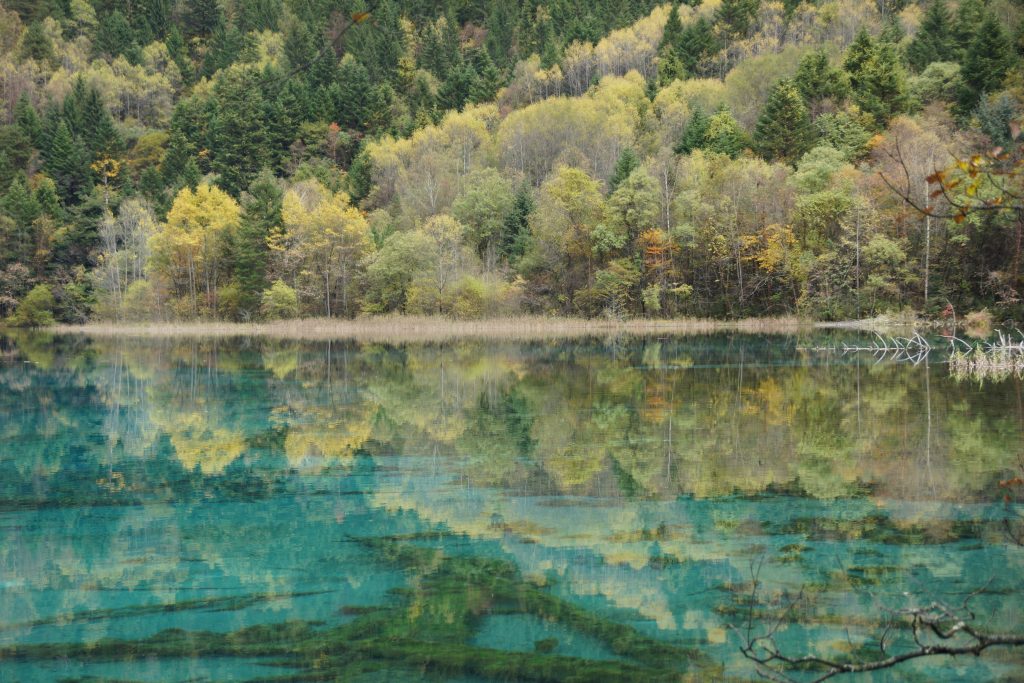
Jiuzhaigou Highlight-If you’ve ever wondered what it’s like to step into a painting, Jiuzhaigou Valley in Sichuan Province is your answer. This UNESCO World Heritage site isn’t just a national park—it’s a living kaleidoscope of turquoise lakes, cascading waterfalls, and forests that blaze with color. Locals call it the “Valley of Nine Villages,” named after the Tibetan settlements that have guarded its secrets for centuries.
Why It’s Magic
The star attractions are Jiuzhaigou’s crystal-clear lakes, formed by ancient glacial shifts and mineral-rich waters. Five Flower Lake looks like someone spilled liquid gemstones—its surface shifts between sapphire and emerald, revealing submerged tree trunks preserved like underwater sculptures. At Nuorilang Waterfall, China’s widest travertine cascade, icy meltwater thunders down a 270-meter-wide curtain of rock. Come autumn (mid-October to early November), the valley explodes into gold and crimson, with maple leaves framing the lakes like stained glass.
Getting There: It’s an Adventure
Jiuzhaigou isn’t on the high-speed rail grid, but that’s part of its charm. Most travelers start in Chengdu, Sichuan’s laid-back capital:
- By Air: A 1-hour flight from Chengdu to Jiuzhai Huanglong Airport (JZH), followed by a 1.5-hour shuttle ride to the park entrance. Catch morning flights—afternoon fog often delays landings.
- By Bus: A 10-hour overnight sleeper bus from Chengdu’s Xinnanmen Station. Not for the faint-hearted (think mountain roads), but cheaper and loved by backpackers.
- Road Trip: Rent a car for the 8-hour drive through the Minjiang River Valley. Stop at Tibetan villages for yak butter tea—locals might invite you to their hearths.
Inside the Park: Play Smart
The park operates eco-friendly buses, but skip the crowds with these tips:
- Go Early: Gates open at 7 AM. Aim to arrive by 6:30 AM—foggy mornings make the lakes glow.
- Reverse Route: Most tour groups start at the bus terminal. Head straight to Long Lake first (the park’s highest point) and walk downhill to avoid herds of selfie sticks.
- Must-See Spots:
- Mirror Lake at dawn: The water becomes a perfect reflection of the sky.
- Panda Lake: No actual pandas, but the blue-green hues are unreal.
- Zharu Valley: A lesser-known hiking trail where Tibetan prayer flags flutter above hidden waterfalls.
Sleep & Eat
Stay in Zhangzha Town, 5 minutes from the park. Budget travelers swear by family-run guesthouses like Jiuzhaigou Shaer Hostel (ask for homemade barley bread). For luxury, InterContinental Jiuzhai Paradise has heated floors and mountain views. Avoid park restaurants—pack nuts, dried fruit, and instant noodles (hot water is free at rest stops).
Survival Notes
- Altitude: The park sits at 2,000–3,100 meters. Take it slow; some vendors sell oxygen cans.
- Cash Only: Cards rarely work here. ATMs in Zhangzha Town dispense yuan.
- Respect the Rules: Swimming in lakes is banned—local Tibetans believe they’re sacred.
Final Wisdom
Jiuzhaigou reopened in 2022 after earthquake repairs, but mass tourism hasn’t ruined its soul—yet. Go now, before Instagram crowds do. Pack a raincoat (weather shifts fast), wear sturdy shoes, and leave your drone at home (they’re prohibited). When you see that first unreal-blue lake, you’ll forget every bumpy bus ride it took to get there.
Fun fact: Locals say Jiuzhaigou’s water gets its color from a goddess’s broken mirror. After visiting, you might just believe them.
